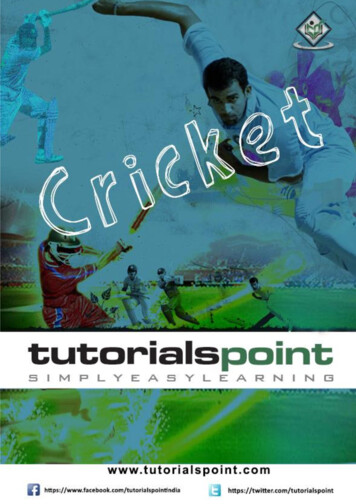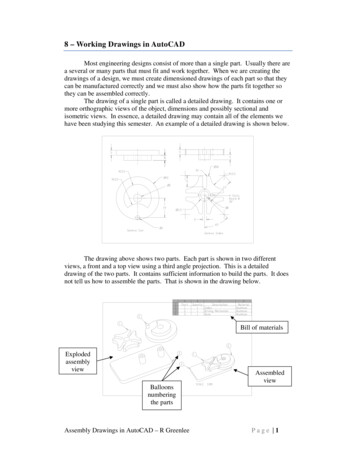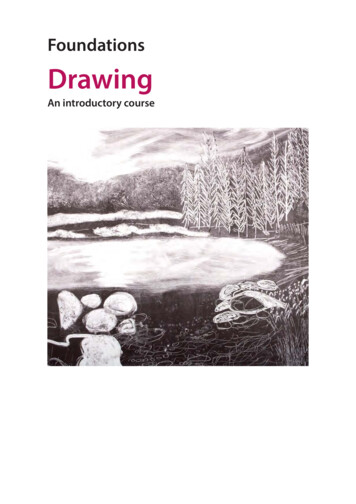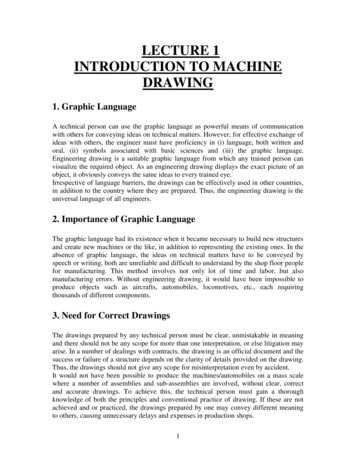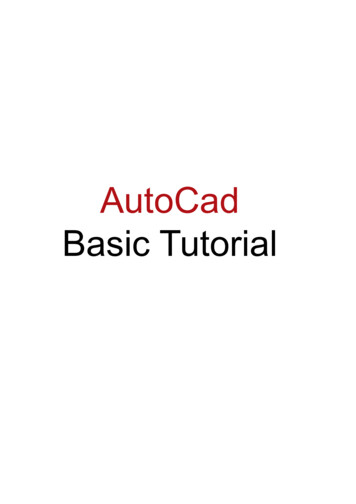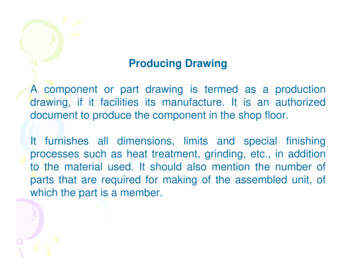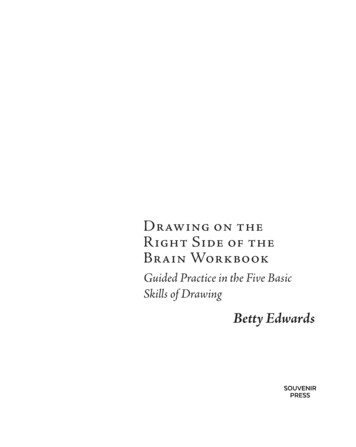
Transcription
Drawing on theRight Side of theBrain WorkbookGuided Practice in the Five BasicSkills of DrawingBetty EdwardsEdwards 9781585429226 tx xp r1.indd 320/08/2020 16:00
Published in Great Britain in 2020 bySouvenir Press,an imprint of Profile Books Ltd29 Cloth FairLondonec1a 7jqwww.profilebooks.co.ukPreviously published in Great Britain in 2003 by Souvenir PressFirst published in the United States in 2002 and 2012 by TarcherPerigee,an imprint of Penguin Random HouseCopyright Betty Edwards, 2002, 2012Book design by Joe Molloy10 9 8 7 6 5 4 3 2 1Printed and bound in Italy by L.E.G.O. SpaWhile the author has made every effort to provide accurate telephone numbers and Internet addresses at the time of publication,neither the publisher nor the author assumes any responsibility for errors, or for changes that occur after publication. Further, thepublisher does not have any control over and does not assume any responsibility for author or third-party websites or their content.The moral right of the author has been asserted.All rights reserved. Without limiting the rights under copyright reserved above, no part of this publication may be reproduced,stored or introduced into a retrieval system, or transmitted, in any form or by any means (electronic, mechanical, photocopying,recording or otherwise), without the prior written permission of both the copyright owner and the publisher of this book.A CIP catalogue record for this book is available from the British Library.ISBN 978 1 78816 366 8Edwards 9781585429226 tx xp r1.indd 420/08/2020 16:00
ContentsForewordviiMaterialsxiGlossary of TermsPart IThe Perceptionof EdgesPart IIThe Perceptionof Spaces9781585429226 DrawingOn TX.indd vxiiiThe Exercises1Exercise 1Pre-Instruction Self-Portrait2Exercise 2Pre-Instruction Drawing of Your Hand4Exercise 3Pre-Instruction Drawing of the Corner of a Room6Exercise 4Warm-up and Free Drawing9Exercise 5The “Vase/Faces” Drawing13Exercise 6Upside-Down Drawing17Exercise 7Pure Contour Drawing27Exercise 8Drawing Your Hand on the Plastic Picture Plane30Exercise 9Setting a Ground33Exercise 10Transferring Your Hand Drawing from Picture Plane to Paper36Exercise 11Drawing Your Hand Holding an Object39Exercise 12Drawing a Flower43Exercise 13Drawing an Orange46Exercise 14Drawing Leaves Using Negative Spaces49Exercise 15Drawing a Chair in Negative Space52Exercise 16Drawing a Household Object56Exercise 17Negative-Space Drawing of a Sports Photograph59Exercise 18Negative-Space Drawing of an Actual Chair62Exercise 19Copying a Master Drawing by Vincent van Gogh6626/11/19 12:52 pm
Part IIIThe Perceptionof RelationshipsPart IVThe Perceptionof Lightsand ShadowsPart VThe Perceptionof the GestaltExercise 20Sighting an Open Doorway70Exercise 21Sighting a Room Corner76Exercise 22The Knee/Foot Drawing79Exercise 23Sighting a Still Life of Books on a Table82Exercise 24A Still Life with Ellipses87Exercise 25Sighting Relationships in a Figure Drawing90Exercise 26Proportions of the Head in Profile96Exercise 27Copying a Master Drawing of a Profile Portrait100Exercise 28Drawing a Profile Portrait104Exercise 29Still Life with American Flag107Exercise 30Drawing Eggs Lighted from Above110Exercise 31Charlie Chaplin in Light and Shadow114Exercise 32Proportions of the Head in Full-Face View116Exercise 33A Full-Face Portrait118Exercise 34Drawing Your Self-Portrait in Lights and Shadows122Exercise 35Using Ink and Brush129Exercise 36An Urban Landscape Drawing132Exercise 37Hatching and Crosshatching137Exercise 38A Figure Drawing in Crosshatch140Exercise 39The “da Vinci Device”: Imaginative Drawing144Exercise 40A Four-by-Four Drawing147Some Suggestions for Further StudyEdwards 9781585429226 tx xp r1.indd 615024/08/2020 11:05
ForewordLearning to draw is very much like learning how to play a sport or howto play a musical instrument. Once you have mastered the fundamentals,advancement in skills is based on practice, practice, practice. Drawing isalways the same task, requiring the same five perceptual skills that, withpractice, become integrated into the whole skill—called a “global” skill—ofdrawing. Only the subjects and mediums change. Therefore, after you havelearned the five basic component skills of drawing, it really does not greatlymatter what you draw. Any subject will do, and any medium will do. This isnot surprising: all global skills are composed of basic component skills thatare always activated when the global skill is being used—think of driving avariety of automobiles, playing tennis on different courts, or reading one ofmany books. No matter what car, court, or book is involved, you effortlesslyuse the skills you have developed over time.This revised workbook is designed as a supplement to my book Drawing on the Right Side of the Brain.* Its purpose is to provide convenient andeffective guided practice for the five basic skills of drawing described in moredetail in the book. The workbook and the book can stand on their own, orthe two can be used in tandem to combine the underlying ideas with practical exercises.The exercises in this workbook include many of the subjects from thedrawing book, including some unfamiliar kinds of drawings (upside-downdrawing, for example) and a variety of subjects appropriate for practicingeach component skill, including working with subject matter beyond thatin Drawing on the Right Side of the Brain. For your convenience, this workbook contains an essential drawing tool, a plastic Picture Plane/Viewfinder,which will help you to understand the basic nature of drawing.This current workbook is smaller and more portable than the first edition, so that you can put it to use in those odd moments of available timewhile waiting in the dentist’s office or at the airport. As you complete theexercises in these pages, you will be creating a permanent, bound record ofyour progress in drawing.*Betty Edwards, Drawing on the Right Side of the Brain, Souvenir Press, 2013viiEdwards 9781585429226 tx xp r1.indd 720/08/2020 16:01
I have found, however, that many of my students who have learned thebasic drawing skills find it difficult to choose subjects to draw. Often, feelingthe urge to draw something that catches their eye, they hesitate for fear thatthe subject may be too hard or that they will not have time to finish. Thisworkbook is designed to solve such problems by providing suitable subjectsfor practicing each skill. In addition, the workbook offers brief instructions,an estimate of the time required (though this will vary somewhat accordingto your own pace), and suitable drawing paper, with ready-drawn formatsand guiding crosshairs in correct proportions for each drawing. For mostof the exercises, I have added post-exercise remarks that provide additionalinformation, suggestions, or helpful pointers.I would guess that the biggest difficulty you will experience in workingthrough these pages is finding the time to draw. It rarely works to tell yourself that you will draw for an hour each day, or even an hour each week. Thecommitment of even that much time will probably seem too great. You mustremember that your brain’s language mode—the left-hemisphere, verbalanalytic brain mode—does not want you to draw at all, because it is “setaside” while you are drawing. The language mode is very good at presenting reasons why you should not draw: you need to pay your bills, call yourmother, answer your e-mail, or just tend to whatever other business is athand.Once you actually “get into” drawing, however, time passes seamlesslyand productively. Therefore, I recommend to you what has worked for me:a version of the so-called two-minute miracle, a technique physical therapists use to enable people to exercise even when they don’t want to. They aretaught to say to themselves, “I don’t have time to take a walk right now, butI will walk for just two minutes.” Once they are actually walking, of course,they forget their objections and continue walking.Here is my version of the two-minute miracle. Keep this drawing work book in a convenient place, along with your pencils and erasers. Sit downfor a moment and take the workbook in hand, saying to yourself, “I’m notreally going to draw now, but I’ll just turn to the next exercise.” Then, takethe next step: “I’m not really going to draw, but I’ll just pick up the pencilviii9781585429226 DrawingOn TX.indd viiiForeword26/11/19 12:52 pm
and make a few marks to start this drawing.” Then, “I’m not really going todraw, but I’ll just sketch in some of the main edges in this drawing . . .” andso on. You will soon find yourself with a completed drawing—and unawarethat time has passed.I realize that this may sound simplistic, but it does work. I have completed entire projects using this technique—a technique of (let’s face it)tricking the language mode of the brain into allowing creative work. Youmay find this hard to believe, but the single most difficult problem for artstudents and even for working artists is getting the work done. One is alwaysfighting the delaying tactics of the verbal system, whose mantra is “Not now.”At its most extreme, the result is writer’s block or artist’s block; a milder version is called procrastination.These drawing exercises are designed to give you success at every step. Ihave high hopes that you will enjoy the process.Note to the reader:You will find more information onthe relationship of drawing to thebrain and creativity in my book,Drawing on the Right Side of theBrain, which is widely available inbookstores and libraries.ForewordEdwards 9781585429226 tx xp r1.indd 9ix20/08/2020 16:01
MaterialsThe art materials needed for these exercises are available in any art supplystore. They can also be purchased by mail or through the Internet, by doinga search for “art materials” or “art supplies.”PencilsErasersHand-held pencil sharpenerGraphite stickCharcoal pencilSynthetic charcoalConté crayons in pencil formErasable felt-tip markerInkBrushMirrorMasking tapeAlarm clock or kitchen timerPaper towels or tissuesWhite computer (or bond) paperLightweight cardboard#2 yellow writing pencil with aneraser top#4b drawing pencil, Turquoise,Faber Castell, or a similar brandA white plastic eraser (Staedtler) ora Pink Pearl eraser#4b#4b1 stickone #3b black and one red(sanguine)1 black (Crayola, Sharpie, or asimilar brand)1 small bottle of black India ink#7 or #8 inexpensive watercolorbrushA small, lightweight, unframedmirror, about 5" 7" or 6" 8"Artist’s Low TackAbout 12 sheets1 piece, 8" 10", to make a frame forthe Picture Plane/Viewfinderxi9781585429226 DrawingOn TX.indd xi26/11/19 12:52 pm
Glossary of TermsAbstract drawing. A transla-tion into drawing of a real-lifeobject or experience. Usuallyimplies the isolation, emphasis,or exaggeration of some aspectof the real world. Or: Uses avisual language of form, line, orcolor to create a compositionthat may exist with a degree ofindependence from visual references in the world.Awareness. Consciousness; theact of “taking account” of anobject, person, or surroundings.Possible synonyms are “seeing”or “cognition.”Basic Unit. A “starting shape” or“starting unit” chosen fromwithin a composition for thepurpose of maintaining correctsize relationships in a drawing. The Basic Unit is alwaystermed “one” and becomes partof a ratio, as in “1:2.”Brain mode. A mental state,implying emphasis on particular capabilities of thehuman brain, such as languageprocessing or visual spatial processing.Cognitive shift. A transference ofthe predominance of one mental state to another, e.g., fromRight brain hemisphere.verbal, analytic left-hemispheremode to visual, spatial righthemisphere mode, or vice versa.Composition. An ordered relationship among the parts orelements of an artwork. Indrawing, the arrangement ofshapes and spaces within theformat.Contour. In drawing, a line thatrepresents the shared edges ofshapes, or shapes and spaces.Crosshatching. A series of intersecting sets of parallel linesused to indicate shading or volume in a drawing. Also called“hatching.”Edge. In drawing, a place wheretwo things meet (for example,where the sky meets theground); the line of separationLeft brain hemisphere.(called a contour) between twoshapes or a space and a shape.Eye level. In portrait drawing, thehorizontal proportional linethat divides the head approximately in half. The eye-levelline is located at this halfwaymark on the head. In perspective drawing, eye-level line issynonymous with “horizonline.”Foreshortening. A means ofcreating the illusion of projecting or receding forms on a flatsurface.Format. The particular shape ofa drawing surface (rectangular,square, triangular, etc.); theproportional relationship of thelength to the width of a rectangular surface.xiii9781585429226 DrawingOn TX.indd xiii26/11/19 12:52 pm
Image. Verb: To call up in theLight logic. In art, the effectmind a mental copy of something not present to the senses;to see in the mind’s eye. Noun:A retinal image; an opticalimage received by the visualsystem and interpreted or reinterpreted by the brain.Imagination. In art, a recombination of mental images frompast experiences into newexpressive patterns.Intuition. Direct and apparentlyunmediated knowledge; a judgment, meaning, or idea thatoccurs to a person without anyknown process of reflectivethinking; an idea that seems to“come from nowhere.”Left-handedness. About ten percent of the population prefersusing the left hand for motoractivities such as writing ordrawing. Hemispheric locationof brain functions may vary inboth left- and right-handers.Left hemisphere. The left halfof the brain. For most righthanded individuals, verbalfunctions are mainly located inthe left hemisphere.caused by a light source. Lightrays, falling in straight lines,can logically be expected tocause the following: highlights,cast shadows, reflected lights,and crest shadows.L-mode. A mental state of information processing characterized as linear, verbal, analytic,and logical.Negative spaces. The areasaround positive forms that,in drawing, share edges withthe forms. Negative spaces arebounded by the outer edges ofthe format. “Interior” negativespaces can be parts of positiveforms.Pencil grades. The grade numberstamped on drawing pencilsindicates the hardness or softness of the graphite. “h” indicates “hard”; “b” (illogically)indicates “black” or “soft.” “hb”divides grades between hardand soft by a middle grade,thus you will find pencilsmarked 8h (the hardest), 6h,4h, 2h, hb, 2b, 4b, 6b, 8b (thesoftest). The #2 yellow writingxiv9781585429226 DrawingOn TX.indd xivpencil is the equivalent of thehb or, more commonly, the 2bdrawing pencil.Perspective and proportion.Also known as perceived relationships. In art, how the partsof an artwork are organized andconnected to create the illusion of space and distance ona flat surface. Specifically, therelationship of angles to verticaland horizontal and the relationship of sizes to each other.Picture plane. An imaginarytransparent plane, like a framedwindow, that always remainsparallel to the vertical planeof the artist’s face. The artist draws on paper what heor she sees through the planeas though the view were flattened on the plane. Inventors ofphotography used this conceptto develop the first cameras.(Note: a Picture Plane/Viewfinder is included with thisworkbook.)Realistic drawing. The objectivedepiction of objects, forms, andfigures attentively perceived.Also called “naturalism.”Glossary of Terms26/11/19 12:52 pm
Right hemisphere. The right halfof the brain. For most righthanded individuals, visual,spatial, relational functionsare largely located in the righthemisphere.R-mode. A state of mental processing characterized as visual,spatial, simultaneous, global,and relational.Sighting. In drawing, sometimescalled “informal perspective.”Measuring relative sizes bymeans of a constant measure(the pencil held at arm’s lengthis the most usual measur-ing device); determining thelocation of one part relativeto another part; determiningangles relative to vertical andhorizontal, and sizes relative toa Basic Unit.Symbol system. In drawing, a setof symbols that are consistentlyused to form an image—forexample, a face or figure. Thesymbols are usually used insequence, one appearing to callforth another, much in the manner of writing familiar words.Symbol systems in drawn formsare usually established in child-Glossary of Terms9781585429226 DrawingOn TX.indd xvhood and often persist throughout adulthood unless modifiedby learning new ways to drawone’s perceptions.Value. In art, the darkness or lightness of tones or colors. Whiteis the lightest, or highest, value.Black is the darkest, or lowest,value.Viewfinder. A device used by artists to frame a view and providebounding edges to a composition; similar to the framingdevice on a camera that enablesthe user to compose a plannedphotograph.xv26/11/19 12:52 pm
rcises9781585429226 DrawingOn TX.indd 126/11/19 12:52 pm
nstructionSelf-PortraitPart IThe Perceptionof EdgesExerciseMaterials:Purpose of the exercise:Wall mirrorPre-instruction drawings provide a valuable record of your drawing skillsnow, a record that will enable you to appreciate your advance in skills at alater date.Masking tape#2 yellow writing pencilInstructions:Hand-held pencil sharpener1.Place a chair in front of a mirror on the wall or tape a small (say, 6" 8")mirror to the wall.2. Sit at arm’s length from the mirror, leaning your workbook against thewall and resting the bottom of the workbook on your knees. If necessary, adjust the mirror so that you can see your head and face.3. Draw your self-portrait to the best of your ability, using the formatprinted on page 3.4. When you have finished, date and sign your drawing.Chair to sit inTime needed:About 30 minutes, more if desiredPost-exercise remarks:People are often highly critical of their pre-instruction self-portrait, but ifyou look closely, you will see areas where you were truly drawing your perceptions—perhaps the turn of the eyelid, the shape of an ear, or the line ofa collar. The quality of the drawing may surprise you. Or, if you can find nomore to say than “Ugh!” about your drawing, be patient. Drawing is a skillthat can be taught and can be learned; it is not magic, and it does not dependon genetic good fortune to be “born an artist.”29781585429226 DrawingOn TX.indd 2Exercise 1Pre-Instruction Self-Portrait26/11/19 12:52 pm
struction Drawing #1: Self-PortraitExercise 19781585429226 DrawingOn TX.indd 3Pre-Instruction Self-Portrait326/11/19 12:53 pm
nstruction Drawingof Your HandPart 1The Perceptionof EdgesExerciseMaterials:Instructions:#2 yellow writing pencil1. Sit at a table with the workbook arranged at a comfortable angle.2. Try out various positions of your non-drawing hand (the left if you areright-handed, or the right if you are left-handed), and choose a position.3. Hold your posing hand still and make a drawing of it, using the formatprinted on page 5.4. Sign and date your drawing.Pencil sharpenerTime needed:About 15 minutes, more if needed49781585429226 DrawingOn TX.indd 4Exercise 2Pre-Instruction Drawing of Your Hand26/11/19 12:53 pm
struction Drawing #2: My HandExercise 29781585429226 DrawingOn TX.indd 5Pre-Instruction Drawing of Your Hand526/11/19 12:53 pm
nstruction Drawingof the Corner of a RoomPart 1The Perceptionof EdgesExerciseMaterials:Instructions:#2 yellow writing pencil1.Look around the room in which you are working and choose one cornerto draw. It can be a simple, empty corner, a corner with a few items, or avery complicated scene.2. Sit in a chair with the workbook on your lap, facing the chosen cornerat a distance of about 8 to 10 feet.3. Draw the room corner to the best of your ability, using the printed format on page 7.4. Sign and date your drawing.Pencil sharpenerTime needed:About 20 minutes, more if needed69781585429226 DrawingOn TX.indd 6Exercise 3Pre-Instruction Drawing of the Corner of a Room26/11/19 12:53 pm
struction Drawing #3: A Room CornerExercise 39781585429226 DrawingOn TX.indd 7Pre-Instruction Drawing of the Corner of a Room726/11/19 12:53 pm
2627282930313233343536373839404142434445S46NSome examples of student progressMaria Catalina OchoaPre-instruction “Self-Portrait.”May 30, 2010Maria Catalina OchoaPost-instruction “Self-Portrait.”June 3, 2010James VanreuselPre-instruction “Self-Portrait.”November 13, 200689781585429226 DrawingOn TX.indd 8Exercise 3James VanreuselPost-instruction “Self-Portrait.”November 17, 2006Pre-Instruction Drawing of the Corner of a Room26/11/19 12:53 pm
Exercise 34 Drawing Your Self-Portrait in Lights and Shadows 122 Part V Exercise 35 Using Ink and Brush 129 The Perception Exercise 36 An Urban Landscape Drawing 132 of the Gestalt Exercise 37 Hatching and Crosshatching 137 Exerci


